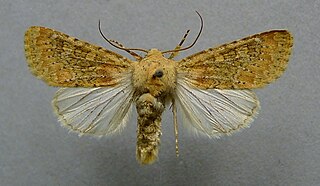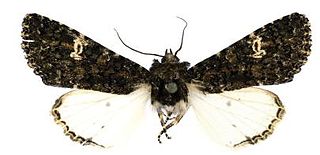
The Noctuidae, commonly known as owlet moths, cutworms or armyworms, are a family of moths. They are considered the most controversial family in the superfamily Noctuoidea because many of the clades are constantly changing, along with the other families of the Noctuoidea. It was considered the largest family in Lepidoptera for a long time, but after regrouping Lymantriinae, Catocalinae and Calpinae within the family Erebidae, the latter holds this title now. Currently, Noctuidae is the second largest family in Noctuoidea, with about 1,089 genera and 11,772 species. This classification is still contingent, as more changes continue to appear between Noctuidae and Erebidae.

Cuculliinae is one of the larger subfamilies of moths in the family Noctuidae.

The large ranunculus is a moth of the family Noctuidae. It is found in Europe and North Africa.

Polymixis polymita is a moth of the family Noctuidae. It is found in most of Europe, but not in the Benelux, Britain, Ireland and the Iberian Peninsula.

Antitype is a genus of moths of the family Noctuidae. The genus was erected by Jacob Hübner in 1821.
Ecbolemia was a genus of moths of the family Noctuidae. It is now considered a synonym of Scythocentropus. It contained four species, which are all transferred to other genera or placed in synonymity.
Eumichtis is a subgenus of moths of the genus Polymixis, and the family Noctuidae.

Polymixis is a genus of moths in the family Noctuidae.
Rivula tanitalis is a species of moth of the family Noctuidae first described by Hans Rebel in 1912. It is found in Morocco, Egypt, Algeria, Malta, Crete, Greece, Lebanon, Iraq, Iran, Saudi Arabia, Yemen and Israel.
Autophila anaphanes is a moth of the family Erebidae first described by Charles Boursin in 1940. It is found in the eastern part of the Mediterranean, including the Balkans, Cyprus, Turkey, Lebanon and Israel.

Heliothinae is a small, cosmopolitan subfamily of moths in the family Noctuidae, with about 400 described species worldwide. It includes a number of economically significant agricultural pest species, such as Helicoverpa armigera and Helicoverpa zea.

The Erebidae are a family of moths in the superfamily Noctuoidea. The family is among the largest families of moths by species count and contains a wide variety of well-known macromoth groups. The family includes the underwings (Catocala); litter moths (Herminiinae); tiger, lichen, and wasp moths (Arctiinae); tussock moths (Lymantriinae), including the arctic woolly bear moth ; piercing moths ; micronoctuoid moths (Micronoctuini); snout moths (Hypeninae); and zales, though many of these common names can also refer to moths outside the Erebidae. Some of the erebid moths are called owlets.

Polymixis xanthomista, the black-banded polymixis, is a moth of the family Noctuidae. The species was first described by Jacob Hübner in 1819. It is found in western Europe, southern Europe and east to Romania, Hungary and Slovenia and also in North Africa. In the Alps it can be found at up to 2000 metres above sea level.

The Erebinae are a subfamily of moths in the family Erebidae erected by William Elford Leach in 1815. Erebine moths are found on all continents except Antarctica, but reach their greatest diversity in the tropics. While the exact number of species belonging to the Erebinae is not known, the subfamily is estimated to include around 10,000 species. Some well-known Erebinae include underwing moths (Catocala) and witch moths (Thermesiini). Many of the species in the subfamily have medium to large wingspans, up to nearly 30 cm in the white witch moth, which has the widest wingspan of all Lepidoptera. Erebine caterpillars feed on a broad range of plants; many species feed on grasses and legumes, and a few are pests of castor bean, sugarcane, rice, as well as pistachios and blackberries.

Polymixis argillaceago is a moth of the family Noctuidae. It is found in south-western Europe and the Maghreb countries.

Polymixis ivanchiki is a moth of the family Noctuidae. It is found in the Near East and the southern parts of Turkey.

Polymixis iatnana is a moth of the family Noctuidae. It is found on Cyprus.

Caradrina selini is a moth of the family Noctuidae. It was described by Jean Baptiste Boisduval in 1840. It is found in most of Europe, North Africa and the Near East.

Athetis hospes, or Porter's rustic, is a moth of the family Noctuidae which was described by Christian Friedrich Freyer in 1835. It is found in Spain, southern France, Italy, on the Balkan Peninsula, Crete, Turkey and northern Iran. The species seems to be expanding its range in north-western Europe with records from Great Britain and the Netherlands.


















